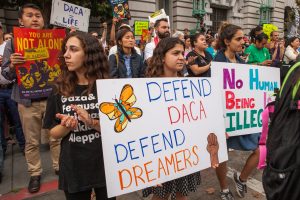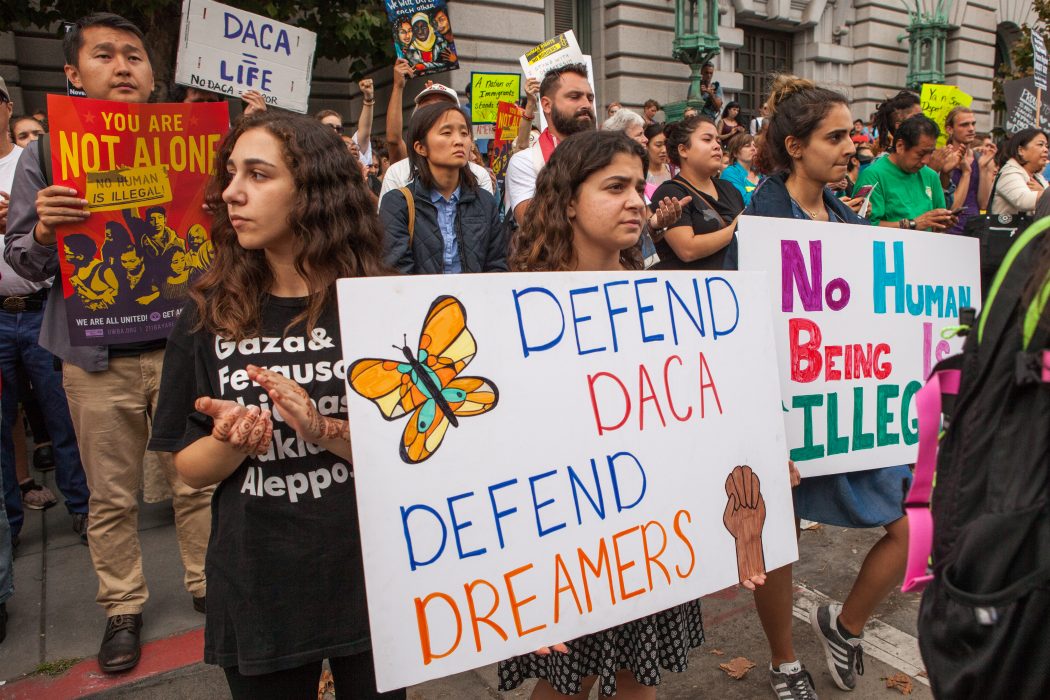The current policy bylaws of most medical schools make a commitment to support increasing diversity of students entering medical school and to increase the pipeline of students who identify as underrepresented minorities. Within this purview, there is a unique medical student population at the heart of this goal, students who identify as Deferred Action Childhood Arrivals, or DACA students. DACA students are young adults who immigrated to and have lived in the United States since childhood without legal documentation, hence the term childhood arrivals. These citizens, approximately 800,000 in number, were granted temporary, renewable resident status and work permits for periods of two years, with protection against deportation and eligibility after two years to apply for permanent residence, hence the term deferred action. In addition to residency requirements, individuals who apply for DACA must demonstrate their exceptionalism through continued education or honorable military discharge. The immigration policy, established by the Obama administration in 2012, currently hangs in flux with its rescindment by the Trump administration in 2017 and lack of a permanent Congressional replacement solution at the time of this article’s publication. As one of the central cornerstones of DACA is continued education, there is a sizable group of international pre-med, medical students, residents who hold or have held DACA status. They, like any US-born medical student, work towards the same path to continue their medical education and serve their community as physician healers.
 What does it mean to be a DACA student pursuing a medical degree? What are the institutional and government barriers they face? What are the unique attributes DACA students bring to their medical class, and how do DACA students uniquely serve the diverse patient population of their community? These are only some of the questions that begin to address the complexity and special circumstances that encompass a DACA student’s journey to medicine. And while I discuss aims to bring awareness to these unique circumstances facing DACA students, I am first to admit that, as a US-born student, I am not the most adept to answer them. As The University of Arizona College Of Medicine – Phoenix does not accept DACA students, my experiences with DACA are through the eyes of my colleagues attending one of the other 68 allopathic medical schools in the US currently accepting DACA students. I could only write this piece because of their lessons and friendship.
What does it mean to be a DACA student pursuing a medical degree? What are the institutional and government barriers they face? What are the unique attributes DACA students bring to their medical class, and how do DACA students uniquely serve the diverse patient population of their community? These are only some of the questions that begin to address the complexity and special circumstances that encompass a DACA student’s journey to medicine. And while I discuss aims to bring awareness to these unique circumstances facing DACA students, I am first to admit that, as a US-born student, I am not the most adept to answer them. As The University of Arizona College Of Medicine – Phoenix does not accept DACA students, my experiences with DACA are through the eyes of my colleagues attending one of the other 68 allopathic medical schools in the US currently accepting DACA students. I could only write this piece because of their lessons and friendship.
While DACA students represented a small proportion of medical school applicants in the past, their application numbers increased dramatically over the last five years. Every year, more public and private medical schools expand their admissions policy to make DACA students eligible to apply and matriculate. The large absence of current DACA students in Arizona’s MD programs have lasting, severe consequences. Not only does such exclusion deprive opportunity for academically competitive, motivated pre-health students in Arizona, but it deprives the diverse, medically underserved communities in Arizona who need internationally diverse physicians with a range of language and cultural skills. As recognized by the American Medical Association, “DACA physicians are more likely to work in high-need areas where communities face challenges in recruiting other physicians.” If Congress allows the program to continue, the AMA projects an additional 5400 previously ineligible physicians into the medical workforce in the coming decades.
Even for students who are accepted into medical school, they are barred from the federal financial aid most medical students use to finance their education. Access to state loans and private sponsorships are sparse, and the prohibitive effects of these financial barriers are clear. Despite rising number of applicants, there are only 65 DACA-status students studying at medical schools across the US and 12 residents at US GME programs. The AAMC estimates a single physician regularly takes care of an average of 1500 patients a year. “If you multiply the 65 DACA status students currently in medical school by 1500, that’s nearly 100,000 future patients who will be affected if these students are unable to finish their medical training,” said Karen Fisher, chief public policy officer with the AAMC. The AAMC, recognizing the unique role DACA students in the US healthcare workforce and the distinct financial barriers they face, issued multiple statements supporting expansion of medical school admissions to DACA students and encouraging lawmakers to grant DACA-aspiring physicians eligibility for federal student loans.
Ultimately, as stated by the International Medical Graduate Taskforce, “Allowing DACA recipients to go into the medical field is as much about serving our national interests as it is a question of compassion.” DACA medical students, acutely conscious of the need to bring awareness to their journey and needs, are not passive in this process. They are advocating, enlightening their medical colleagues, and making themselves and their outstanding contributions known to the medical community. Recent publications by DACA medical students are inspiring and need to be distributed among the medical and political community so they may fully understand what is at stake with the institutional exclusions of DACA students from medical schools and the larger federal threat of revoking DACA status. A medical student DACA recipient emigrating from Gujarat, India, when she was only 3 years old, explains her DACA journey succinctly and poignantly, with a mission for us all to reflect on:
I have worked tirelessly to serve my communities and push myself to be a physician this country and the AMA can be proud of. My journey to medical school and my goals for the future are a testament to my commitment to the people of America and to the medical profession. From the day we began our medical education, we have been welcomed into your dedicated, cerebral and forward-thinking community We have not given up on the people of this great nation, so please do not give up on us.
I will not give up on DACA students pursuing their medical education, for we need each other. As I prepare to graduate medical school and enter residency, I envision my 10-year medical school reunion. I’ll know we’ve made progress when I return to campus to meet a new first-year student accepted to medical school regardless of their immigration status. I envision he/she dressed in the red and blue UA colors, studying ahead, confident that their school and their country fully support them to become the physician of their dreams.
Arielle Eliz Rubin is a medical student at The University of College of Medicine – Phoenix. Raised and educated in Tempe, Arizona, she studied history and Spanish at Arizona State University. She is co-chair of the campus Psychiatry Interest Group and Latino Medical Student Association (LMSA). She currently serves on the LMSA National Board as Internal Policy Chair. Research endeavors include a thesis on the cultural and religious determinants of reproductive healthcare in Spain and a scholarly project assessing trauma exposure during border-crossing experiences of Latina women. She enjoys salsa dancing, museum explorations, and traveling with friends.

